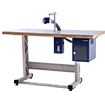How the pneumatic vacuum cleaner gun work?

Pneumatic systems use compressed air to perform mechanical work.
Pneumatic systems use compressed air to perform mechanical work. In the context of a vacuum cleaner gun, it could involve a tool powered by compressed air to create suction for cleaning purposes. Here is a general explanation of how such a system might work:
1. **Compressed Air Source:** The system requires a source of compressed air, often provided by an air compressor. Compressed air is stored in a tank or generated in real-time for immediate use.
2. **Air Flow Control:** There is a mechanism for controlling the flow of compressed air. This can include a trigger or valve that the user operates to regulate the airflow.
3. **Suction Mechanism:** The compressed air is used to create a vacuum or suction. This suction can be generated by creating a pressure differential between the tool's nozzle and the surrounding environment.
4. **Nozzle and Collection:** The vacuum cleaner gun would have a nozzle or attachment designed for the specific cleaning task. This nozzle is placed over the area to be cleaned, and the suction created by the compressed air draws in debris or particles.
5. **Dust Collection:** The collected dust or debris is typically deposited into a container or bag that is part of the vacuum cleaner system. Depending on the design, the collected material may be separated from the airflow using filters or other mechanisms.
6. **Exhaust:** After the air has passed through the system and collected debris, it is expelled back into the environment. Some systems may include additional filtration to ensure that only clean air is released.
It's important to note that the specific design and components of a pneumatic vacuum cleaner gun can vary based on the manufacturer and the intended application. If there have been new developments or specific products introduced after my last update in January 2022, I recommend checking the latest sources or the manufacturer's documentation for the most accurate and up-to-date information.
1. **Compressed Air Source:** The system requires a source of compressed air, often provided by an air compressor. Compressed air is stored in a tank or generated in real-time for immediate use.
2. **Air Flow Control:** There is a mechanism for controlling the flow of compressed air. This can include a trigger or valve that the user operates to regulate the airflow.
3. **Suction Mechanism:** The compressed air is used to create a vacuum or suction. This suction can be generated by creating a pressure differential between the tool's nozzle and the surrounding environment.
4. **Nozzle and Collection:** The vacuum cleaner gun would have a nozzle or attachment designed for the specific cleaning task. This nozzle is placed over the area to be cleaned, and the suction created by the compressed air draws in debris or particles.
5. **Dust Collection:** The collected dust or debris is typically deposited into a container or bag that is part of the vacuum cleaner system. Depending on the design, the collected material may be separated from the airflow using filters or other mechanisms.
6. **Exhaust:** After the air has passed through the system and collected debris, it is expelled back into the environment. Some systems may include additional filtration to ensure that only clean air is released.
It's important to note that the specific design and components of a pneumatic vacuum cleaner gun can vary based on the manufacturer and the intended application. If there have been new developments or specific products introduced after my last update in January 2022, I recommend checking the latest sources or the manufacturer's documentation for the most accurate and up-to-date information.














